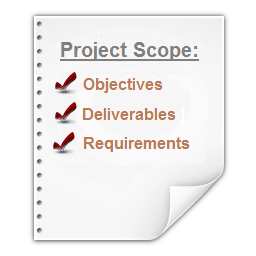Project Benefits: Classification (Quantitative, Qualitative, Direct, Enabling, Synergistic)
 Any project is regarded as successful if its benefits are derived upon completion. The best management practices prove that success of projects can be measured in terms of their ability to deliver benefits. In this context, obviously it is important to recognize and classify benefits derived from the project. Clear and exact classification of project benefits will help more efficiently monitor the project and better understand the impact of delays, changes to scope, and lowered performance to project results.
Any project is regarded as successful if its benefits are derived upon completion. The best management practices prove that success of projects can be measured in terms of their ability to deliver benefits. In this context, obviously it is important to recognize and classify benefits derived from the project. Clear and exact classification of project benefits will help more efficiently monitor the project and better understand the impact of delays, changes to scope, and lowered performance to project results.
The project benefits classification includes the following types of benefits:
- Quantitative and qualitative benefits
- Direct, enabling and synergistic benefits
Quantitative and Qualitative Benefits
When planning for a new project, all potential benefits within this project can be divided into the following two main categories:
- Quantitative Benefits. Examples are cycle time to increase throughput, elimination of time-wasting tasks and inefficient processes, lowered level of material resources utilization to get same outputs, etc.
- Qualitative Benefits, including quality management, improved project requirements compliance and regulation, secured access to corporate information, increased staff motivation, etc.
All classified benefits should have an assigned owner – the person or a group of concerned people who typically receive the project benefits. The benefit owner is committed to ownership and provided with measures and tools to figure out whether the benefits have been achieved.
Direct, Enabling and Synergistic Benefits
With relation to how potential benefits will be used by the benefit owner, they can be classified into the following kinds:
- Direct Benefits are derived directly from the project and meet interests of concerned people. Example: implementation of a new task management system into offices of an organization will provide staff members with direct benefits of managing tasks and office workflows better.
- Enabling Benefits are particular to projects that bring no specific benefits but which are critical to the delivery of the benefits from associated projects. Example: if a company takes the initiative to improve skills and knowledge of personnel involved in managing projects, this initiative delivers no direct benefits; however, it will improve the company’s ability to run and complete projects on time, and therefore it contributes to the possibility of getting benefits from future projects.
- Synergistic or Collaborative Benefits are particular to a group of projects when every of the projects brings no (or only small) contribution unless all the projects are combined into a single complex project. Example: an advertising campaign for a new product delivers no direct benefits but when it’s combined with associated projects to establish manufacturing, distribution, warehousing, quality management, and a wide range of other items, it becomes a part of a synergistic result.
- Passenger or Contributing Benefits produce additional benefits to other projects which bring their own benefits. Example: an organization launches an ad campaign so this is the primary project which brings the direct benefits of the widened customer audience and increased sales. Meanwhile, the campaign influences other activities (procurement, delivery, legal advice, etc.) of the organization, building a foundation for earning passenger benefits. The campaign may attract new vendors and contribute to establishing new contracts and developing business reputation of the organization.
The Link Between Benefits and Deliverables
Normally, project benefits are linked to project deliverables. The benefits of a project can be derived when they are combined with the successful realization of project deliverables. For example, an organization wants to improve productivity of its employees to meet an increased demand for brand products and to deliver more qualified services to customers. In this case customer satisfaction is the benefit which the organization tends to derive. A simple requirement to improve employee productivity can turn into a complex project to develop skills of employees and to modernize existing work environment standards. The improved employee productivity is likely to depend on successful completion of the following (deliverables):
- Engaging trainers and mentors to provide the employees with high-quality extension courses and trainings
- Implementing a new HR management system to control and monitor employee performance and absence
- Changing existing work environment standards to get the new system working
- Making some changes to the senior management to hire more competent HR managers and supervisors
Each of these items can be considered as deliverables. In case all of them result in successful completion, the benefit (customer satisfaction) will be derived and maximized. If any of the deliverables is failed, the organization will get no project benefits whilst separate deliverables are achieved.














